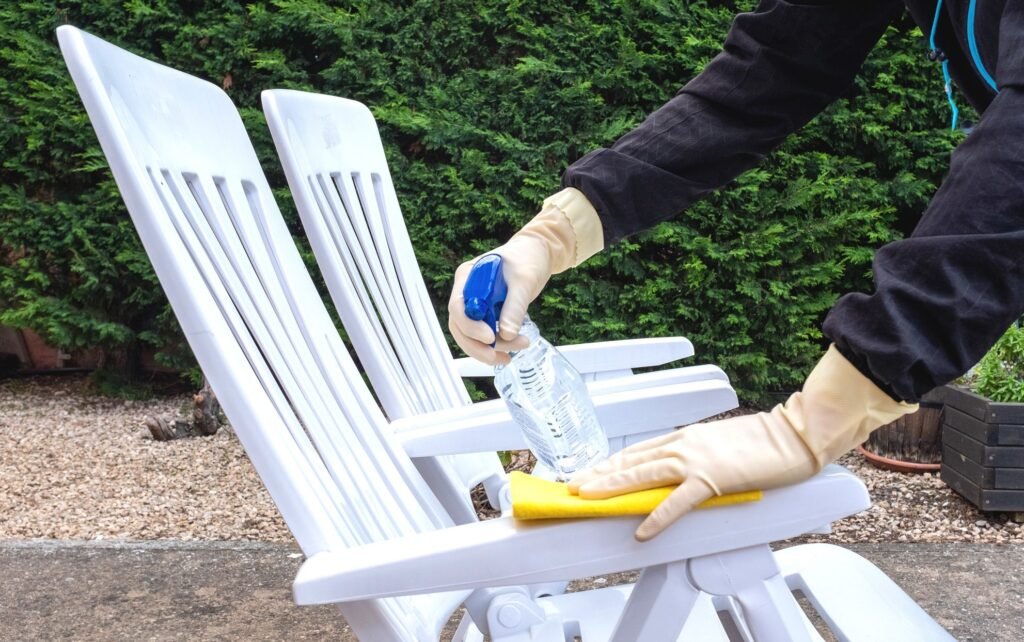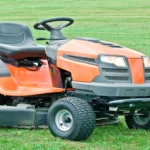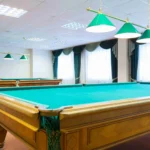Mold on wood furniture can be unsightly and harmful. It can cause damage to the furniture and pose health risks. Addressing mold promptly ensures the longevity of your furniture and a healthier home environment. Start by gathering necessary supplies like mild detergent, warm water, a soft brush, and a clean cloth.
Ensure the area is well-ventilated to prevent mold spores from spreading. Use protective gear like gloves and a mask to safeguard yourself. Regular cleaning and proper maintenance can prevent future mold growth. By following these steps, you can effectively remove mold and keep your wood furniture in pristine condition.

Identifying Mold Damage
Mold on wood furniture can be a serious issue. It not only looks unpleasant, but can also damage the furniture and affect your health. Removing mold requires careful attention and proper methods. First, you need to identify the damage. This guide will help you recognize mold signs and assess the damage extent.
Recognizing Signs Of Mold
Mold can appear in various forms on wood furniture. Look for discolored patches that are green, black, or white. Mold often has a fuzzy texture. It may also have a musty smell.
Here are some common signs of mold on wood furniture:
- Discoloration: Spots that are darker or lighter than the wood.
- Texture: Fuzzy or powdery substance on the surface.
- Smell: A musty or earthy odor.
Check hidden areas like the underside or back of the furniture. Mold can grow in unseen places. Use a flashlight to inspect dark corners. Also, pay attention to any changes in the wood. Warping or cracking can indicate mold damage.
Assessing The Extent Of Damage
After identifying mold, it’s crucial to assess how much damage has occurred. This helps determine the right removal approach. Start by examining the surface area affected by mold. Use a measuring tape to get an idea of the size. Next, check if the mold has penetrated deep into the wood. Lightly press the affected area with a tool. If the wood feels soft, the mold has likely caused significant damage.
Here is a simple table to help you assess the damage:
| Damage Level | Signs |
| Minor | Small patches, no soft spots, surface discoloration |
| Moderate | Medium patches, slight soft spots, mild odor |
| Severe | Large patches, deep soft spots, strong odor |
For minor damage, a simple cleaning might suffice. For moderate to severe damage, consider professional help. Always wear protective gear while assessing mold. Mold spores can be harmful to health. Use gloves, masks, and goggles for safety.
Preparing For Mold Removal
Mold can be a big problem for wood furniture. It can make furniture ugly and even damage it. Removing mold is important to keep your furniture looking good and lasting a long time. Preparing for mold removal is the first step to ensure you do the job right.
Gathering Necessary Supplies
Having the right supplies is important for remove mold from wood furniture.
Here is a list of items you will need:
- Rubber gloves – Protect your hands from mold and cleaning chemicals.
- Face mask – Prevents you from breathing in mold spores.
- Goggles – Shields your eyes from mold and cleaning sprays.
- Soft brush – Helps to scrub the mold off the wood.
- Vacuum cleaner with HEPA filter – Captures mold spores during cleaning.
- Buckets – Holds cleaning solutions.
- Mild detergent – Cleans the wood surface gently.
- White vinegar – Kills mold naturally.
- Soft cloths or sponges – Used for wiping and cleaning.
- Disposable rags – For drying and disposing of moldy residues.
Putting together these supplies makes the mold removal process easier and safer. Using mild detergent mixed with water is a good way to clean wood furniture. White vinegar is also effective in killing mold. Soft brushes and cloths help scrub and wipe without damaging the wood. A vacuum cleaner with a HEPA filter can capture mold spores and prevent them from spreading. Always have enough disposable rags to dry and clean the furniture properly.
Protecting Yourself And The Surrounding Area
Safety is important when remove mold from wood furniture. Protecting yourself and the surrounding area will help you stay safe.
Here are some steps to follow:
- Wear protective gear – This includes gloves, a face mask, and goggles.
- Work in a well-ventilated area – Open windows and doors to let fresh air in.
- Cover nearby items – Use plastic sheets or old cloths to cover other furniture and floors.
- Seal off the area – Close off the room or area where you are working to prevent mold from spreading.
- Dispose of moldy items properly – Use sealed bags to throw away rags and other moldy materials.
Wearing protective gear keeps you safe from mold spores and cleaning chemicals. Working in a well-ventilated area helps reduce the concentration of mold spores in the air. Covering nearby items prevents mold from spreading to other areas. Sealing off the area ensures the mold doesn’t spread to the rest of your home. Proper disposal of moldy items ensures the mold doesn’t come back.
Removing Mold From Wood Furniture
Mold on wood furniture can be a real problem. It not only looks bad, but can also cause health issues. Remove mold from wood furniture is essential to keep your home safe and clean. This guide will help you understand how to tackle both surface and penetrating mold effectively.
Cleaning The Surface Mold
Start by wearing protective gear, like gloves and a mask. This keeps you safe from mold spores. Move the furniture outside if possible. This prevents mold spores from spreading indoors. Use a soft brush to gently scrub off the visible mold. Be careful not to damage the wood. After scrubbing, mix 1 cup of vinegar with 1 cup of water. Dampen a cloth with this solution and wipe down the affected area. Vinegar is a natural disinfectant and will help kill the mold.
Allow the furniture to air dry completely. Do not use excessive water, as it can damage the wood. If the mold is stubborn, you can use a mixture of baking soda and water. Make a paste and apply it to the moldy spots. Scrub gently with a brush, and wipe clean with a damp cloth.
- Wear protective gear
- Move furniture outside
- Brush off visible mold
- Use vinegar and water solution
- Allow to air dry
Treating Penetrating Mold
Penetrating mold goes deeper into the wood. This type of mold is more challenging to remove. First, sand the affected area using fine-grit sandpaper. This helps remove the mold that has penetrated the wood. Be sure to sand gently to avoid damaging the furniture. Once sanded, use a vacuum cleaner to remove the dust and mold particles.
Next, apply a commercial mold remover. Follow the instructions on the product label. Some products may require you to let the solution sit for a few minutes. After applying the mold remover, use a clean cloth to wipe the area. Rinse with clean water and let it dry completely. Finally, consider applying a wood sealant. This helps protect the wood from future mold growth.
- Sand the affected area
- Vacuum the dust
- Apply commercial mold remover
- Rinse and let dry
- Apply wood sealant
Drying And Restoring The Furniture
Remove mold from wood furniture can be a challenging task. Mold not only damages the furniture, but also poses health risks. Drying and restoring the furniture correctly is crucial. This guide will help you ensure proper drying and restoration of wood furniture after mold removal.
Ensuring Proper Drying
Proper drying is essential to prevent mold from returning. Start by placing the furniture in a well-ventilated area. Open windows and doors to allow air circulation. If the weather is humid, use a dehumidifier. This helps reduce moisture in the air.
Use fans to speed up the drying process. Place them around the furniture, aiming the airflow towards it. Rotate the furniture occasionally to ensure even drying. Avoid direct sunlight, as it can damage the wood.
Here are some steps to ensure proper drying:
- Place the furniture in a dry, well-ventilated area.
- Use fans to circulate air around the furniture.
- Check the furniture regularly for any signs of moisture.
- Use a dehumidifier if the air is humid.
Monitor the moisture levels in the wood. You can use a moisture meter for this. The wood should have less than 20% moisture content before restoration.
Restoring The Wood
Restoring the wood helps restore its original look. Begin by cleaning the wood with a mild detergent and water. Use a soft cloth to avoid scratching the surface. Wipe down the wood gently.
Sand the wood to remove any residual mold stains. Use fine-grit sandpaper for this task. Sand in the direction of the grain to avoid damage. Clean the dust with a damp cloth.
Here are the steps to restore the wood:
| Step | Action |
| 1 | Clean the wood with mild detergent and water. |
| 2 | Sand the wood using fine-grit sandpaper. |
| 3 | Wipe the dust with a damp cloth. |
| 4 | Apply wood polish or finish to protect the surface. |
Apply wood polish or finish to protect the surface. This will also restore the natural shine of the wood. Follow the manufacturer’s instructions for the best results. Allow the polish or finish to dry completely before using the furniture.
Preventing Future Mold Growth
Mold on wood furniture can cause damage and health issues. It’s important to remove mold and prevent its return. This guide will help you understand how to clean mold and keep your furniture safe.
Implementing Preventive Measures
To prevent mold growth, keep your home dry. Mold loves moisture. Ventilate rooms well to reduce humidity. Use dehumidifiers and fans to keep air moving. Also, place furniture away from walls to let air flow.
Check for leaks in your home. Fix any plumbing issues immediately. Mold grows fast where water is present. Seal windows and doors to keep moisture out. Another tip is to use mold-resistant paint on walls and ceilings.
Keep wood furniture clean and dust-free. Dust can hold moisture and help mold grow. Use a vacuum with a HEPA filter to remove dust. Don’t forget to clean under and behind furniture too. Use mold inhibitors in cleaning products.
- Keep your home dry
- Ventilate rooms
- Fix leaks and plumbing issues
- Seal windows and doors
- Use mold-resistant paint
- Clean and dust furniture
- Use mold inhibitors
Regular Maintenance
Regular maintenance is key to keeping mold away. Check your furniture often for any signs of mold. Look for discoloration or a musty smell. If you find mold, clean it immediately with mild soap and water.
Keep a schedule for cleaning. Dust and vacuum your furniture every week. Use a soft cloth to wipe surfaces. Also, polish wood furniture every few months. This helps protect the wood and keep it dry.
Store wood furniture in a dry place. If you have a basement, use dehumidifiers to keep the air dry. Avoid placing furniture in damp areas. If you must store it in a basement, elevate it off the ground.
Here are some tips for regular maintenance:
- Check furniture for mold signs
- Clean with mild soap and water
- Dust and vacuum weekly
- Wipe surfaces with a soft cloth
- Polish wood every few months
- Store in dry places
- Use dehumidifiers in damp areas
Frequently Asked Questions
Can Moldy Wood Furniture Be Saved?
Yes, moldy wood furniture can be saved. Clean it with a mixture of water and vinegar. Sand and refinish if needed. Ensure proper ventilation to prevent future mold growth.
What Kills Mold Spores On Wood Furniture?
White vinegar and baking soda kill mold spores on wood furniture. Apply, scrub gently, and wipe clean. Ensure proper drying.
What Kills Mold On Wood Instantly?
White vinegar kills mold instantly on wood. Spray it on the affected area and let it sit for an hour.
Does Vinegar Remove Mold From Wood Furniture?
Yes, vinegar can remove mold from wood furniture. Mix equal parts vinegar and water, then scrub the affected area.
Conclusion
Remove mold from wood furniture is crucial for maintaining its beauty and durability. Follow the steps outlined to ensure thorough cleaning. Regular maintenance helps prevent mold growth. Keep your furniture dry and well-ventilated. With these tips, your wood furniture will remain pristine and mold-free for years to come.







